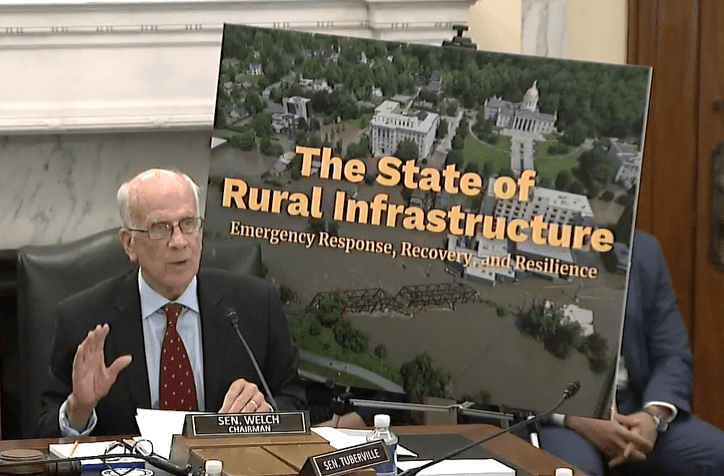Hearing held on the one-year anniversary of the Vermont floods
WASHINGTON, D.C. – On Wednesday, Senator Peter Welch (D-Vt.) convened a Senate Agriculture Subcommittee on Rural Development and Energy hearing entitled, “The State of Rural Infrastructure: Emergency Response, Recovery, and Resilience.” The hearing fell on the one-year anniversary of the July 2023 Vermont floods, and on a day when areas across Vermont received more torrential rain and flooding as the remnants of Hurricane Beryl hit the state.
At the hearing Senator Welch highlighted his recently introduced Rural Recovery Act. The bill would provide U.S. Department of Agriculture Rural Development (RD) state offices—which are on the front lines helping communities facing natural disasters—automatic funding for emergency recovery technical assistance after a presidentially-declared disaster. The program is modeled after a pilot program spearheaded by USDA RD and the Vermont League of Cities and Towns, which provides towns with technical assistance for disaster recovery.
“It was a year ago, on July 10th and 11th, that we had the catastrophic flood. And I want to acknowledge, by the way, the first responders, the medical professionals, the police, fire and rescue, National Guard, relief agencies, and neighbors who helped everyone in a moment of crisis. And I want to take a moment to acknowledge the Vermonters who lost so much: their homes, their businesses, their farms, their communities. It’s really a traumatic experience that lingers and is a long-term struggle to get over,” said Senator Welch.
Senator Welch highlighted how Vermont communities are grappling with lasting impacts from the floods, including in Johnson and Montpelier:
“If there’s one thing these disasters have made clear, it’s that we need to put resilience in the capacity of local communities and states to essentially build back better so that when the next storm comes, there’s going to be a lot less damage, or maybe no damage at all if we do it right,” said Senator Welch. “Our small communities can’t do it on their own….We need to make sure that the federal programs are spending money to help disaster victims, but not on administrative costs as much, but more on actual relief. And we had a situation in Vermont where there was [almost] two times the amount spent on administration than there was on relief. And obviously we want to turn that upside down—that’s where the local engagement is so essential. We need to act now.”
Senator Welch questioned witnesses about the challenges rural communities in Vermont face in accessing federal disaster assistance funds, and how investments in climate resilience made after Tropical Storm Irene in 2011 helped Vermont’s infrastructure withstand the July 2023 floods.
Mr. Ted Brady, Executive Director of the Vermont League of Cities and Towns, testified: “[S]imply put, it’s capacity. In Vermont, of the 247 cities and towns and another 31 or so villages, less than half—about 40%—have professional career staff to help manage the town….That means 60% of Vermont does not have professional capacity to deal with these things…it’s really overwhelming.”
Ms. Julie S. Moore PE, Secretary of the Vermont Agency of Natural Resources, described investments in climate resilience as “critical.” She testified: “We modernized our codes and standards to reflect the kinds of rainfall patterns we’re seeing in the 2020s as opposed to what we were seeing in the 1960s, which had been the rainfall data driving much of our design.” By doing so, she concluded, “The overall damage to our road and bridge infrastructure was significantly lower than it was…I think a lot of that is a reflection of changes we’ve made and how we size our infrastructure.” Ms. Moore described investments made to the public buildings in Winooski following Tropical Storm Irene as “a night and day difference how strategic investments in hardening as well as resiliency can help us withstand a wider range of weather events.”
Senator Welch also asked witnesses for suggestions on how Congress can ensure USDA RD resources can help communities rebuild in the wake of disasters.
Ms. Moore testified that USDA RD has the “technical know-how and capacity to support communities in thinking through what the best long-term decisions are.” She continued: “Knowing where to turn with those important questions, being able to not just react in the moment but think for the long-term and having partners that stand ready and available to provide that kind of support in the moment is really essential.”
Watch the Senator’s full remarks below:

In addition to Mr. Brady and Ms. Moore, the hearing featured testimony from Hon. Kevin Paap, County Commissioner of Blue Earth County in Minnesota, which recently experienced catastrophic flooding, as well as Mark Bohlin of Perdido Bay Water and Brad Kimbro of Wiregrass Electric Cooperative. Senator Welch chaired the hearing with Ranking Member Tommy Tuberville (R-Ala.).
Senator Welch has visited and met with municipal, state, and federal leaders across Vermont in the aftermath of the damaging floods in Vermont to survey the impacts firsthand and to help Vermonters recover and build back stronger. Senator Welch has urged his colleagues to pass disaster supplemental funding for Vermont’s flood-impacted homeowners, farmers, and businesses.
Last month, Senator Welch shared a new report released by the U.S. Senate Joint Economic Committee’s Democratic majority that found flooding damage costs an equivalent of 1-2% of U.S. GDP, or $180-$496 billion, each year. The analysis found that the ongoing impacts of climate change were likely to increase costs in the future. Another recent analysis found that every $1 spent on flood resiliency efforts saves up to $318 in flood-related damages.
###
